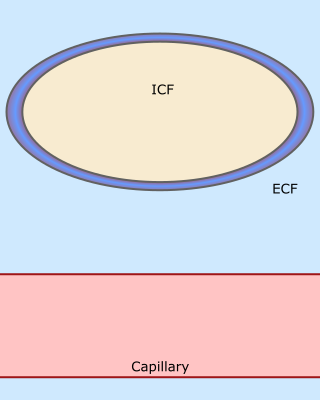Questions and Answers
Question: How does the capillary membrane differ from the cell membrane in terms of movement of glucose, ions and water across it?

Fig 1 Passage of water and ions through different fluid compartments
Question: How does the capillary membrane differ from the cell membrane in terms of movement of glucose, ions and water across it?

Question: How does the capillary membrane differ from the cell membrane in terms of movement of glucose, ions and water across it?
Answer: Since glucose, ions and water readily pass through the capillary membrane, the osmolality of extravascular and extracellular fluid is the same as it is for plasma. However, the cell membrane is impermeable to certain ions, sodium in particular. Sodium concentration is the major determinant of fluid distribution across membranes. Glucose can enter the cell only by facilitated diffusion, in exchange for sodium. Once in the cell, glucose is metabolized to two molecules of 3-carbon sugars. This increases the number of osmotically-active particles and water is drawn into the cell.
Question: Which fluids allow water to move from the ECF into the ICF, and so distribute through the entire volume of body water?

Question: How does the capillary membrane differ from the cell membrane in terms of movement of glucose, ions and water across it?
Answer: Since glucose, ions and water readily pass through the capillary membrane, the osmolality of extravascular and extracellular fluid is the same as it is for plasma. However, the cell membrane is impermeable to certain ions, sodium in particular. Sodium concentration is the major determinant of fluid distribution across membranes. Glucose can enter the cell only by facilitated diffusion, in exchange for sodium. Once in the cell, glucose is metabolized to two molecules of 3-carbon sugars. This increases the number of osmotically-active particles and water is drawn into the cell.
Question: Which fluids allow water to move from the ECF into the ICF, and so distribute through the entire volume of body water?
Answer: Of the isotonic fluids, 0.18% NaCl + 4% glucose and 5% glucose, and all hypotonic fluids, i.e. 0.18% and 0.45% NaCl, allow water to move from the ECF to the ICF.
0.9% NaCl allows water to distribute only in the ECF. The lactate in Hartmann's solution enters the cell taking a small proportion of water with it, but not as much as for the glucose-containing fluids.
